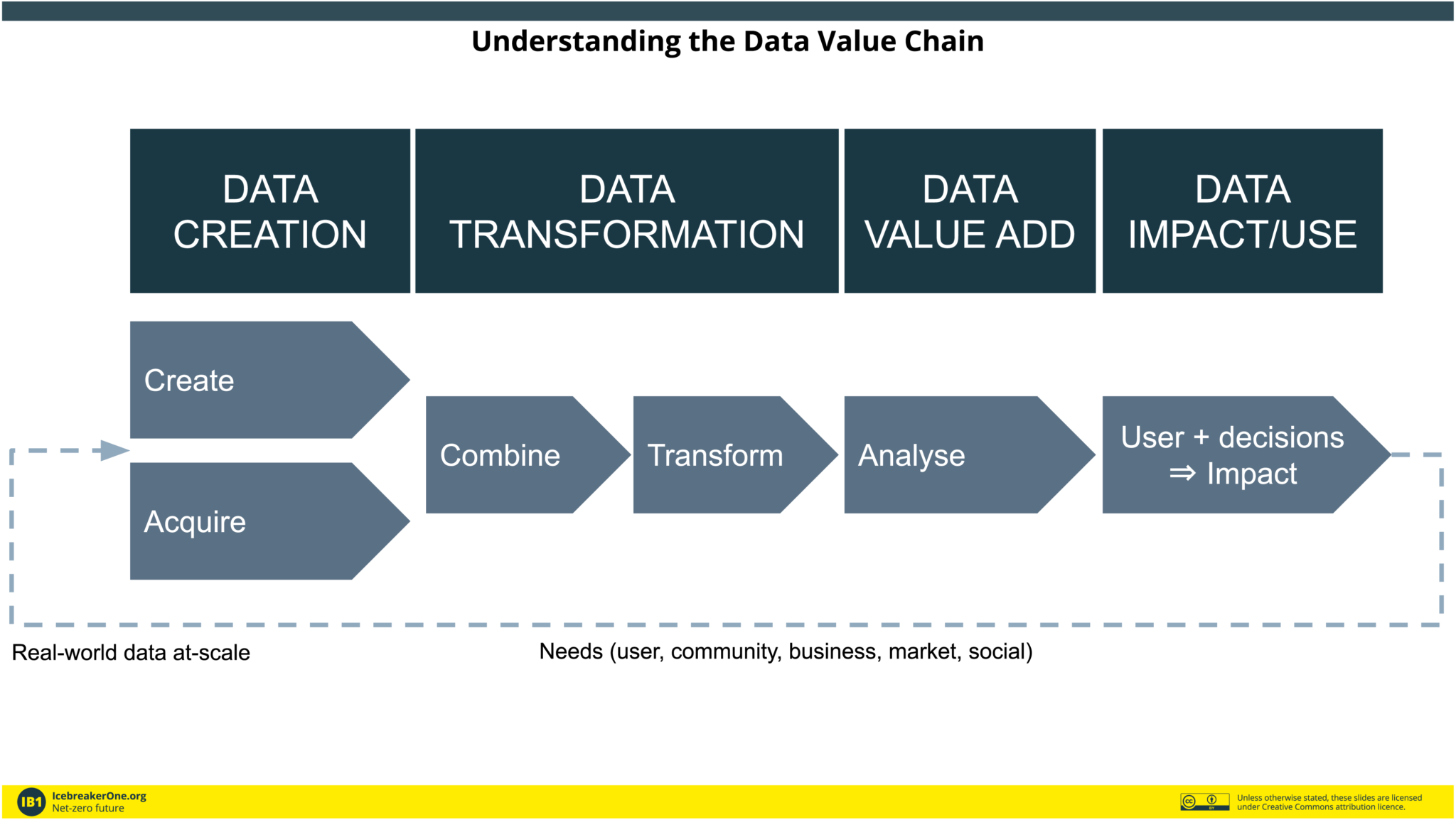For consultation as part of a development process, this report is open to comment by anyone at:
https://bit.ly/ib1-nfdf
[scroll down on this page for re-usable images]
#DataInfrastructure
Goals of this document
In the context of environmental information, comprehensive financial and non-financial reporting by organisations, we aim to demonstrate opportunities that could reduce effort and complement ongoing international initiatives. We present the scope and complexity of data sharing across markets, supply and value-chains. We highlight challenges that create friction, inertia and inhibit action in delivering goals, including hard-programmed habits and underlying presuppositions and premises. We highlight solutions that can reduce friction in data-sharing and propose levers of change that can help unlock innovation (e.g. policy and regulatory, perception shifts, behavioural changes).
Intended audience(s)
Our primary audience includes decision-makers and their advisors who wish to understand the transformative potential of data, and how its usage can be unlocked at scale to enable it to act as a flow of evidence that informs action. While it covers ‘technology concepts’ it is not ‘about’ technology. Rather, it addresses designing the conditions for success that would enable millions of experts, practitioners and organisations to better discover, access and use the data they need to make informed decisions.
This includes, but is not limited to: policymakers and regulators working on Sustainable Finance, Corporate Reporting and Value Chain Due Diligence; experts working across Environmental, Social, and Corporate Governance (ESG), Corporate Social Responsibility (CSR) and related reporting frameworks (e.g. TCFD, SASB); Chief Data Officers and related leaders working on data strategy and policy; solution providers seeking to improve scenario modelling; business leaders optimising efficiency and reducing risk in decision-making.
Executive Summary
The wealth of data we have, and that is becoming available, must now be made usable to help us address climate and environmental risks, and to radically improve our investments in, and planning and management of our global infrastructure. While there is an ocean of available capital, the lack of comprehensive, trusted and quality data-flow is leading to a misallocation of resources, missed opportunities and is creating catastrophic risks on our global balance sheets. Our infrastructure for accessing this data is as important as our physical infrastructure in averting our climate, biodiversity and related crises, but it is being dangerously neglected.
Data for non-financial reporting is, and will increasingly be, required across global value chains. Global cooperation will be needed, ensuring timely, trusted coordination to enable data to flow in ways that all value-chain partners can engage with, align with and accept. Data sharing will, therefore, require an industry-neutral, geography-neutral and context-neutral trust framework and governance to underpin sharing in a non-partisan manner.
Today, the majority of corporate environmental sustainability data published are delivered ‘somewhere online’, often in a PDF format, often inconsistently, in ways that are then aggregated into portals or commercial services that then attempt to translate them into value or risk assessments. There are substantial gaps in the materiality of much of this data, it is often incomplete or not ‘actionable’. The process of data collection, access, sharing and usage are, at best, not fit for purpose.
Fortunately, there are many initiatives addressing the issues of what data may be material (e.g. TCFD, SASB, GRI, CDSB, GHG Protocol). Given that element of the challenge is well understood, our focus is on how to make the information more accessible, usable and impactful.
The opportunity exists to directly affect two parts of the data value chain. Firstly, we can enable better discovery, access and usage of the ‘outputs’ (e.g. TCFD reports). Secondly, and significantly, we can enable better discovery, access and usage of the ‘inputs’ (e.g. the energy consumption of a factory that generates emissions).
There is a bold but achievable route to deliver access to the environmental data with the quality and scope that will be needed for the success of Sustainable Finance, corporate environmental reporting and multinational corporate management of Science Based Targets for GHG emission reduction. This solution can overcome the significant political and cultural barriers and challenges to the current situation of access to suitable data for corporate reporting, financial disclosures and systemic risk modelling.
The proposed solution builds on the proven potential of existing shared data standards development (e.g. currently deployed in Open Banking) and those that lie at the core of the EU’s Digital and Data Strategies, including the Green Deal Dataspace.
Open Banking has already used this approach with great success. Open Banking is used by two million consumers in the UK, and Open Banking practices are now in development across over twenty countries, including Australia, Bahrain, Europe, Hong Kong, India, Japan, Mexico, Malaysia, New Zealand, Rwanda, Singapore and the USA and beyond. The Open Banking market is projected to grow to over $40B by 2026.
Our direct experience shows that the key features of the creation of data flows are not technical (‘ICT’). Therefore, rather than a focus on ‘which data’, ‘which technology’ or ‘what data standards’ (many exist), instead the solution requires addressing the processes and practices that enable data flows that can unlock continuous improvement — using data as material evidence that drives decisions. In order to achieve this at scale, across industries and borders, we need a functioning data ecosystem of users and suppliers of data, and the best way to achieve this is to adopt common, open standards for data sharing. To deliver this requires a governance framework for data access that creates trust.
At the heart of the architecture is a federated approach to data sharing, namely that the data is not centrally stored, it is left with the data owner or controller and consent managed to allow those with permissions to access with conditional rules that have been agreed by the market.
A data governance trust framework addresses three foundational issues. Firstly, it helps align the discovery and access of data in a manner that can scale to millions of use cases. Secondly, it aligns the actors in the system around a secure and trusted environment from which they have a direct benefit to participate (as either a supplier or a consumer of data). Thirdly, critically, a trusted framework can help align organisations around legal, IP, liability and rights issues in a manner that can unlock data sharing between organisations and across borders.
Practical experience in Open Banking, and development of ‘Open Energy’, shows that implementation can grow organically, with strong leadership, appropriate governance, starting small around core use cases, and expanding progressively. Implementation strategies can build on existing experience.
The approach needs organisations to take forward development together. To satisfy all needs, it is best co-designed by the future participants, with that process facilitated by an independent, neutral body. Whilst there are various international, sectoral and regional initiatives attempting to align data standards (for example around taxonomies and ontologies such as the EU taxonomy for sustainable activities), there is a significant (and unnecessary) gap in initiatives to facilitate data discovery, access and usage. Yet, success in this area is essential and can also resolve or reduce some of the most difficult problems around the alignment of data.
A roadmap for this work would include a 3-6 month process of planning, stakeholder curation and engagement, and scoping of test use-cases. Implementation can be delivered through a continuous development process that combines multi-disciplinary working groups to triage, prioritise and work through specific issues linked to the use-case. In parallel, the use case is developed in an active sandbox environment to test the recommendations and identify material blockers. The solution is tested with users and the outcomes fed back into the scoping process for refinement. This process can be run on a continuous 3 or 6-month loop until viable solutions have been identified, tested and proven.
Photo credit: @lceusebio, unsplash. Design: Philpott Design





















